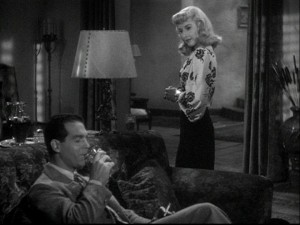The notion of slant and filter as defined in Chapman’s article has sunk in quite a bit, but there are some instances in films that we’ve seen where I try to apply the terms and just get plain old befuddled. So we’re all on the same page, let me copy down the definitions Chapman provides:
Slant – The narrator’s attitudes and other mental nuances appropriate to the report function of discourse.
Filter – The much wider range of mental activity experienced by characters in the story world – perceptions, cognitions, attitudes, emotions, memories, fantasies, and the like.
First example: in the fourth episode of The Singing Detective, there’s one sequence where young Marlowe is riding with his mother on the train to London. Young Marlowe is looking out the window at a scarecrow atop a hill when suddenly, the scarecrow waves. Then, eventually, the same sequence is replayed, but from the other side, crossing the 180 Degree line, showing the head of the scarecrow to be Hitler. Then, Hitler taunts a battalion of British soldiers and they in turn fire upon the scarecrow. So, as I understand it, the flashback sequences are all filtered through Philip Marlowe’s mental processes; we are witnessing his rendering of his past memories. One question I have is are we getting our fabula information filtered through the young Marlowe in the memories, with Older Marlowe as the implied filterer (or the more general focalizer), if you see the distinction? Further, in my mind, there is no possible way that in the memory sequence, young Marlowe could visualize the aspect of the memory with the soldiers. So, is this a flourish provided by the filtered memories of Older Marlowe, or a narrational slant? Or maybe, there are just multiple filterers coinciding with the different ages of Marlowe?
I understand slant to emerge when imformation is presented that cannot possibly be in the scope of knowledge of the filtering character. For example, the glimpse of both Leonard and Sammy in the same wheelchair towards the end of Memento. In my chronology of the fabula, Leonard had already experienced his wife’s rape and thus his memory condition, so how can he have remembered himself in that way? Are these latent memories still in his head that only come forth due to Teddy’s retelling? Are they projections of internal processes going off in Leonard’s head? Possibly, but couldn’t they also be the narrator inserting an opinion towards the correct way to understand the fabula? What has become clear to me is how complicated defining the cinematic language actually is.
Also, one last thing concerning filtering as it relates to Barton Fink. During the sequence where John Goodman’s character runs down the hallway and the walls light up in flame, is that filtered through Barton or John Goodman’s character. As we know, we are given a glimpse of where Barton was situated: in the hotel room on the bed, only able to see the little visible to him through the doorway (the fire lining the walls, John Goodman walking by and reloading his gun). I would presume that Barton may also be able to hear all that goes on outside the room, so it is not a stretch for Barton to filter that sequence based upon the visual and aural clues provided to him. But maybe, John Goodman’s character is filtering the sequence. We do know from Barton’s filtering that the hotel is hot, but maybe the fire along the wall is an external expression of John Goodman’s inner fury, in the same way that Wilson’s article uses the example of Bogart waking up from being drugged and having the spidery fog imposed on the screen while he stumbles around. This would tie into Wilson’s discussion of formal manifestations of subjectivity. Anyway, I’d like to hear of anybody has any opinions on these examples or could provide any other examples that might clear up any misuderstandings I have concerning the terms slant and filter
